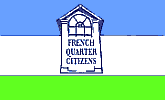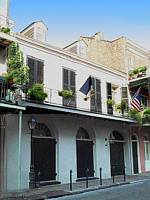
| Home |
| About Us |
| Coming Events |
| News Articles |
| You Can Help |
| History |
| Contacts |
| Links |

History of the
French Quarter
(Since 1718 - Page
1)
by B.B. St. Roman
The French Quarter is the only intact French Colonial and Spanish settlement remaining in the United States. It has been a continuous residential neighborhood since 1718, withstanding hurricanes, floods, fires, yellow fever epidemics, war, neglect, industrialization and commercialization. Its population has varied from 470 people to as many as 11,000. As a registered "National Historic Landmark" the French Quarter has secured an important role in our nation's history.
To trace the key developments in the French Quarter over the last nearly 300 years, here are some of the more significant dates/decades in its history:
1718 - For at least 10,000 years up until 1718, the New Orleans area had been inhabited solely by Native Americans, primarily Choctaw. Since the land lies between the Mississippi River and Lake Pontchartrain, both of which are connected to the Gulf of Mexico, the Native Americans realized that an overland connection between the river and the lake would be important for travel and trade. Therefore, they built a portage from the river (at what is now Conti Street) to Bayou St. John, a stream leading out to the lake. The very first explorer in the area, LaSalle, came down the Mississippi River from Illinois in 1682; however, he cruised right by the New Orleans area without stopping. Later, when he tried to find the river from the Gulf, he ended up in Texas. So in 1699 two French brothers, Iberville and Bienville, decided to try their luck and they succeeded: in 1704 Iberville built a fort at Lake Pontchartrain (now called the "Old Spanish Fort") and wanted to establish a town on Bayou St. John near the portage. However, Bienville preferred the Mississippi River end of the portage, so in 1718 he started building a town at what is now Conti Street.
He and his crew of 80 cleared enough cane growth and dense cypress forest to build one large warehouse and about 100 crude log huts haphazardly scattered along three streets near the riverfront. A major problem during the first few years was flooding.
 |
| A Creole Townhouse
|
1721-22 - Bienville teamed up with two French engineers to design a French military-style city street plan, making New Orleans one of the first planned cities in America. This plan, which has remained to this day, featured a central square (now called Jackson Square) surrounded by a grid of 6 x 9 city blocks. Any existing huts not conforming to the grid were ordered torn down. Nature had already made that easy: a 1721 hurricane had leveled nearly the whole town. The forest was cleared just enough to accommodate the plan, leaving alligator and snake-laden swamps surrounding them on three sides. A levee was built along the Mississippi to protect them from flooding. At the square a church, a rectory and a prison were constructed (right where the present day St. Louis Cathedral, Presbytere and Cabildo stand). Along the rest of the streets (Bienville to Ursulines, the river to Dauphine) residences were built in primarily the French Colonial style: the living quarters raised 8' off the ground, galleries on all four sides, the floodable ground floor used only for storage. The houses were spread out, with fruit and vegetable gardens between them, not close together like today. The only building left from this era is the Ursuline Convent finished in 1745. The house at 632 Dumaine Street known as Madame John's Legacy, though built in 1788, represents this French style. The population grew from 470 in 1721 to a stabilized 5000-6000 in the 1760-70's, with the boundaries of the city still the same as the original Vieux Carré grid.
1762 - The Spanish took control of New Orleans for the next 38 years, introducing the first streetlights, newspaper, theatre and police force. However, the language and culture of the city remained primarily French. The architecture did change dramatically during Spanish rule, due to a...
Home | About Us |
Events | You Can Help |
History | Contacts |
Links| Alert
E-Mail
History Page 1 | History
Page 2 | History Page 3
Copyright 2001-2005 © French Quarter Citizens
All rights Reserved
Site designed by SBeckArt